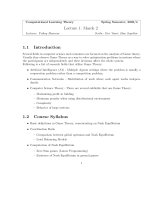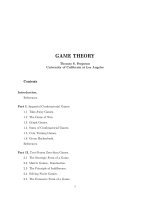lectures note on game theory - john duffy
Bạn đang xem bản rút gọn của tài liệu. Xem và tải ngay bản đầy đủ của tài liệu tại đây (2.36 MB, 210 trang )
What is a Game?
• There are many types of games, board games, card games, video
games, field games (e.g. football), etc.
• In this course, our focus is on games where:
– There are 2 or more players.
– There is some choice of action where strategy matters.
– The game has one or more outcomes, e.g. someone wins,
someone loses.
– The outcome depends on the strategies chosen by all players;
there is strategic interaction.
• What does this rule out?
– Games of pure chance, e.g. lotteries, slot machines. (Strategies
don't matter).
– Games without strategic interaction between players, e.g.
Solitaire.
Why Do Economists Study Games?
• Games are a convenient way in which to
model the strategic interactions among
economic agents.
• Many economic issues involve strategic
interaction.
– Behavior in imperfectly competitive markets,
e.g. Coca-Cola versus Pepsi.
– Behavior in auctions, e.g. Investment banks
bidding on U.S. Treasury bills.
– Behavior in economic negotiations, e.g. trade.
• Game theory is not limited to Economics.
Five Elements of a Game:
1. The players
– how many players are there?
– does nature/chance play a role?
2. A complete description of what the players can
do – the set of all possible actions.
3. The information that players have available
when choosing their actions
4. A description of the payoff consequences for
each player for every possible combination of
actions chosen by all players playing the game.
5. A description of all players’ preferences over
payoffs.
The Prisoners' Dilemma Game
• Two players, prisoners 1, 2.
• Each prisoner has two possible actions.
– Prisoner 1: Don't Confess, Confess
– Prisoner 2: Don't Confess, Confess
• Players choose actions simultaneously without
knowing the action chosen by the other.
• Payoff consequences quantified in prison years.
• Fewer years=greater satisfaction=>higher payoff.
• Prisoner 1 payoff first, followed by prisoner 2 payoff.
Prisoners’ Dilemma in “Normal” or
“Strategic” Form
Prisoner 2↓
5,50,15Confess
15,01,1Don't
Confess
Confess
Don't
Confess
Prisoner 1↓
How to play games using the
comlabgames software
.
• Start the browser software (IE or Netscape).
• Enter the URL address provided on the board.
• Enter a user name and organization=pitt. Then
click the start game button.
• Start playing when roles are assigned.
• You are randomly matched with one other player.
• Choose a row or column depending on your role.
Computer Screen View
Results Screen View
Number of
times row player
has played each
strategy
Number of
times column
player has played
each strategy
Number of times
each outcome has
been realized.
Total Number
of Rounds Played
Prisoners' Dilemma in “Extensive” Form
Don't
Confess
Confess
Prisoner 1
Prisoner 2 Prisoner 2
Don't
Confess
Confess
Don't
Confess
Confess
1,1 15,0
0,15 5,5
This line represents
a constraint on the
information that prisoner
2 has available. While
2 moves second, he does
not know what 1 has
chosen.
Payoffs are: Prisoner 1 payoff, Prisoner 2 payoff.
Computer Screen View
Prisoners' Dilemma is an example
of a Non-Zero Sum Game
• A zero-sum game is one in which the players'
interests are in direct conflict, e.g. in football, one
team wins and the other loses; payoffs sum to zero.
• A game is non-zero-sum, if players interests are not
always in direct conflict, so that there are
opportunities for both to gain.
• For example, when both players choose Don't
Confess in the Prisoners' Dilemma.
The Prisoners' Dilemma is
applicable to many other
situations.
• Nuclear arms races.
• Dispute Resolution and the decision to hire
a lawyer.
• Corruption/political contributions between
contractors and politicians.
• Can you think of other applications?
Simultaneous versus Sequential
Move Games
• Games where players choose actions simultaneously
are simultaneous move games.
– Examples: Prisoners' Dilemma, Sealed-Bid Auctions.
– Must anticipate what your opponent will do right now,
recognizing that your opponent is doing the same.
• Games where players choose actions in a particular
sequence are sequential move games.
– Examples: Chess, Bargaining/Negotiations.
– Must look ahead in order to know what action to choose
now.
• Many strategic situations involve both sequential and
simultaneous moves.
The Investment Game is a
Sequential Move Game
Sender
Receiver
Don't
Send
Send
Keep Return
0,12 6,6
4,0
If sender sends
(invests) 4, the
amount at stake
is tripled (=12).
Computer Screen View
• You are either the sender or the receiver. If you
are the receiver, wait for the sender's decision.
One-Shot versus Repeated Games
• One-shot: play of the game occurs once.
– Players likely to not know much about one another.
– Example - tipping on your vacation
• Repeated: play of the game is repeated with the
same players.
– Indefinitely versus finitely repeated games
– Reputational concerns matter; opportunities for
cooperative behavior may arise.
• Advise: If you plan to pursue an aggressive strategy,
ask yourself whether you are in a one-shot or in a
repeated game. If a repeated game, think again.
Strategies
•A strategy must be a “comprehensive plan of action”, a decision rule
or set of instructions about which actions a player should take
following all possible histories of play.
• It is the equivalent of a memo, left behind when you go on vacation,
that specifies the actions you want taken in every situation which could
conceivably arise during your absence.
• Strategies will depend on whether the game is one-shot or repeated.
• Examples of one-shot strategies
– Prisoners' Dilemma: Don't Confess, Confess
– Investment Game:
• Sender: Don't Send, Send
• Receiver: Keep, Return
• How do strategies change when the game is repeated?
Repeated Game Strategies
• In repeated games, the sequential nature of the relationship
allows for the adoption of strategies that are contingent on the
actions chosen in previous plays of the game.
• Most contingent strategies are of the type known as "trigger"
strategies.
• Example trigger strategies
– In prisoners' dilemma: Initially play Don't confess. If your opponent
plays Confess, then play Confess in the next round. If your opponent
plays Don't confess, then play Don't confess in the next round. This is
known as the "tit for tat" strategy.
– In the investment game, if you are the sender: Initially play Send. Play
Send as long as the receiver plays Return. If the receiver plays Keep,
never play Send again. This is known as the "grim trigger" strategy.
Information
• Players have perfect information if they know
exactly what has happened every time a
decision needs to be made, e.g. in Chess.
• Otherwise, the game is one of imperfect
information
– Example: In the repeated investment game, the
sender and receiver might be differentially
informed about the investment outcome. For
example, the receiver may know that the amount
invested is always tripled, but the sender may not
be aware of this fact.
Assumptions Game Theorists Make
9 Payoffs are known and fixed. People treat expected payoffs
the same as certain payoffs (they are risk neutral).
– Example: a risk neutral person is indifferent between $25 for certain or
a 25% chance of earning $100 and a 75% chance of earning 0.
– We can relax this assumption to capture risk averse behavior.
9 All players behave rationally.
– They understand and seek to maximize their own payoffs.
– They are flawless in calculating which actions will maximize their
payoffs.
9 The rules of the game are common knowledge:
– Each player knows the set of players, strategies and payoffs from all
possible combinations of strategies: call this information “X.”
– Common knowledge means that each player knows that all players
know X, that all players know that all players know X, that all players
know that all players know that all players know X and so on, , ad
infinitum.
Equilibrium
• The interaction of all (rational) players' strategies
results in an outcome that we call "equilibrium."
• In equilibrium, each player is playing the strategy that
is a "best response" to the strategies of the other
players. No one has an incentive to change his
strategy given the strategy choices of the others.
• Equilibrium is not:
– The best possible outcome. Equilibrium in the one-shot
prisoners' dilemma is for both players to confess.
– A situation where players always choose the same action.
Sometimes equilibrium will involve changing action
choices (known as a mixed strategy equilibrium).
Sequential Move Games with
Perfect Information
• Models of strategic situations where there is a
strict order of play.
• Perfect information implies that players know
everything that has happened prior to making a
decision.
• Sequential move games are most easily
represented in extensive form, that is, using a
game tree.
• The investment game we played in class was an
example.
Constructing a sequential move game
• Who are the players?
• What are the action choices/strategies available to
each player.
• When does each player get to move?
• How much do they stand to gain/lose?
Example 1: The merger game. Suppose an industry has
six large firms (think airlines). Denote the largest
firm as firm 1 and the smallest firm as firm 6.
Suppose firm 1 proposes a merger with firm 6 and in
response, Firm 2 considers whether to merge with
firm 5.
The Merger Game Tree
Firm 1
Firm 2 Firm 2
Since Firm 1 moves
first, they are placed
at the root node of
the game tree.
Buy
Firm 6
Don’t Buy
Firm 6
Buy
Firm 5
Don’t Buy
Firm 5
Buy
Firm 5
Don’t Buy
Firm 5
1A, 2A
1B, 2B 1C, 2C 1D, 2D
• What payoff values do you assign to firm 1’s payoffs 1A, 1B, 1C, 1D?
To firm 2’s payoffs 2A, 2B, 2C, 2D? Think about the relative
profitability of the two firms in the four possible outcomes, or
terminal nodes of the tree. Use your economic intuition to rank the
outcomes for each firm.
Assigning Payoffs
• Firm 1’s Ranking: 1B > 1A > 1D > 1C. Use 4, 3, 2, 1
• Firm 2’s Ranking: 2C > 2A > 2D > 2B. Use 4, 3, 2, 1
Firm 1
Firm 2 Firm 2
Buy
Firm 6
Don’t Buy
Firm 6
Buy
Firm 5
Don’t Buy
Firm 5
Buy
Firm 5
Don’t Buy
Firm 5
1A, 2A
1B, 2B 1C, 2C 1D, 2D









